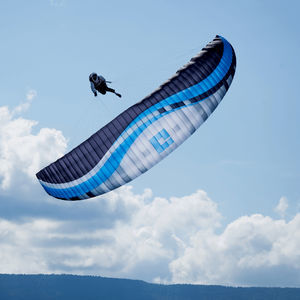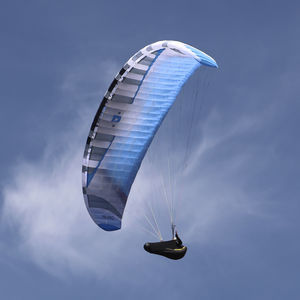

- Products
- Catalogs
- News & Trends
- Exhibitions
Performance paraglider Hike&Cruiseintermediatesingle place

Add to favorites
Compare this product
fo_shop_gate_exact_title
Characteristics
- Applications
- performance, intermediate
- Maximum passengers
- single place
- Wing surface
Max.: 25 m²
(269.1 ft²)Min.: 15.9 m²
(171.1 ft²)- Maximum load
Max.: 105 kg
(231 lb)Min.: 50 kg
(110 lb)- Wingspan
Max.: 11.73 m
(38'05" )Min.: 8.03 m
(26'04" )- Weight
2.37 kg, 2.62 kg, 2.86 kg
(5.22 lb, 5.78 lb, 6.31 lb)
Description
Double skin paraglider with 3-1 system. Light and pleasant, with good performance.
Hike&Cruise is a very light double-skin paraglider for Hike&Fly, bivouac flights, and also as a main wing for free flying.
With a wide speed range, light weight and precise, agile steering, the Hike&Cruise is a great choice for pilots seeking a unique experience in the air.
It is a handy wing that can be packed into a small bag, easy to climb with and descend, or make a longer flight using thermals.
This paraglider features the 3-to-1 technology, ensuring good performance and low weight of the canopy, which in turn makes the wing a great fun to fly.
3-to-1 technology
In the Hike&Cruise construction, we used our innovative 3-to-1 technology, thanks to which we obtained a paraglider weighing 2.37 – 2,73 kg with 65* cells and an aspect ratio of 5.6. The specificity of the 3-to-1 technology allowed to obtain a high level of safety (EN A/B), thanks to which the world of XC and bivouac flights opened up to intermediate recreational pilots.
The idea behind the 3-to-1 technology is to improve the air flow in the upper zones of the canopy that are most crucial for generating lift, while maintaining a low weight. For this purpose, the number of cells on the upper surface of the wing was increased, with simultaneous reduction on the lower surface.
In order to connect the two surfaces of the canopy with a different number of cells, a special system of internal reinforcements has been designed, based on diagonal supports and a reduced number of ribs (as compared to the classic double-skin paraglider). As a whole, the system relies on a complex and visually attractive set of internal structures.
VIDEO
Related Searches
- Paragliding wing
- Racing paraglider
- Single place paragliding wing
- Parachute
- Performance paragliding wing
- Rescue parachute
- Single place parachute
- Paramotor wing
- Single place paramotor wing
- Sport paramotor wing
- Intermediate paragliding wing
- Performance paramotor wing
- Beginner paraglider
- Tandem paraglider
- Intermediate paramotor wing
- Beginner paramotor wing
- Tandem parachute
- Freestyle paraglider
*Prices are pre-tax. They exclude delivery charges and customs duties and do not include additional charges for installation or activation options. Prices are indicative only and may vary by country, with changes to the cost of raw materials and exchange rates.



